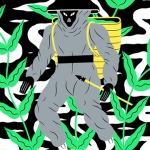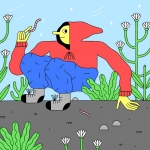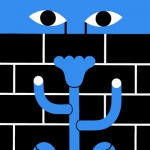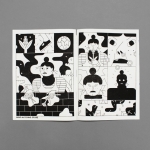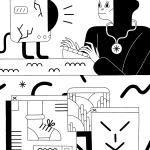Most often, What you see is what you get is an unnerving concept; unless it’s in reference to artist Dominic Kesterton, in which case, it’s a delightful surprise. Bold and fervent, Kesterton manifests in each of his illustrations and publications as the unfiltered creator, offering himself and his loose creativity in even unison. By alternating color and detail, his work brings to focus the mere width of a line (see scenario-laden Unmatter for acute black-and-white allure), giving a glowing, living tinge to even a colorless image.
While running a Riso print service, Workhorse Press, alongside a friend, Kesterton adapts his roles, from printer to storytelling, illustrator to publisher. Perhaps it’s that dedicated flexibility that allows him to jump from literal to abstract without lifting his pen, coupling commonplace details with equivocal form and creating peerless visuals. Get to know Dominic Kesterton, and fall into his dreamlike illustrations, i.e., himself.
Give us the Dominic Kesterton spiel: who are you? what do you do? what’s your favorite food?
I’m an illustrator based in Edinburgh. My favorite food is egg fried rice.
What does a typical day in Edinburgh entail for you? Can you break down a day in Dom’s life for us?
I eat some cereal and then go to the studio in the morning. I’ll look at my emails and mess around for a bit doodling or whatever. Me and a pal run a Riso print service called Workhorse Press from our studio so there is often a bit of printing to do as well. Otherwise, there is no rigid structure really other than working on whatever projects I’ve got on the go; maybe eat some noodles for lunch. At the moment I need to ramp it up and stay in late to get a load of new comics/zines/prints ready for this year. On Monday I didn’t go into the studio, I went to one of those trampoline parks where there are trampolines on every surface.
What dictates the fat strokes, the thin lines, the color blocking in your abstract aesthetic? How much of your work is improvised/planned?
I don’t really consider whats going on too much. With any of my more abstract looking stuff I’m just thinking about what looks balanced and good. I’ll blur my eyes a bit and tilt my head from side to side and hold a drawing at arms length to decide if it’s a good one. I generally like to work in pencil first and then pen, so there is some planning there in a sense. I keep sketchbooks with lots of doodles, so I pull ideas out from there as well.
You become a storyteller through your illustrations. What do you like about the varied storytelling process of time-lapse, something like Unmatter comic, and a standalone illustration?
With Unmatter the comic format let me explore some pretty dumb scenarios that needed just a couple of sequential images. Simple things like falling from a ladder or breaking a vase or whatever. At the moment I don’t want to draw longer comics because it can become a pretty grueling process, so it’s fun to stay free and think of these short little scenarios. With standalone illustrations it’s just fun to try and make a good looking or interesting thing and then move on and make another.
What does a printed DIY publication (a zine, comic or book) mean to you?
For me it’s a fun way to explore my personal work. It’s nice when some one is self publishing because you know you’re getting an unfiltered, pretty direct impression of their work and ideas. This can be good or bad. It can also be quite frustrating if you don’t have the resources to execute your crazy ideas.
What do you listen to while you work? How much does it stimulate your work?
I probably listen to stuff about 50% of the time when I draw—I don’t know how it affects me. I like instrumental music that can lull me into a working groove. I’m listening to Oneohtrix Point Never right now. Quite often when I’m drawing I’ll put a movie on—I end up just listening to the movie though because my eyes are down.
Bill Murray in Groundhog Day or Ghostbusters?
Groundhog Day
For more from Dominic check out his website: www.dominickesterton.com





